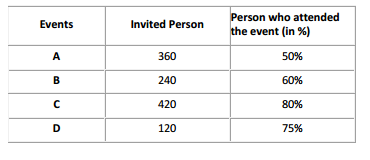Study the following information carefully and answer the given questions :
The number of cricket players in four different academies A, B, C and Dis 120, 150, 100 and 200 respectively.
There are only three types of players in a team: specialist Batsman, specialist bowlers and all-rounders (those who can both bat and ball)
Out of total number of players in academies A, B, C and D, percentage of players who can bat is 75%,80%,60%and 35% respectively.
Out of total number of players in academies A, B, C and D, percentage of players who can bowl is 50%,60%,70% and 80% respectively
Fees paid to one specialist batsman for one match is 3times the fees paid to one all-rounder for one match
Fees paid to one specialist bowler for one match is Rs20000.
Respective ratio between the fees paid to one specialist bowler for one match and the fees paid to one all-rounder for one match is 2:3.
What is the total fees paid to 3 all-rounders A1, A2 and A3 who played six, seven and eight matches respectively? (in Rs lakh)
6.3
4.8
7.2
5.1
The correct Answer is:A
To solve the problem step by step, let's break it down:
Step 1: Determine the Fees for All-Rounders
1. Given Information:
- Fees paid to one specialist bowler for one match = Rs 20,000.
- The ratio of fees paid to one specialist bowler and one all-rounder = 2:3.
2. Calculating the Fees for All-Rounders:
- Let the fees for one all-rounder be x.
- From the ratio, we have:
20000x=23
- Cross-multiplying gives:
2x=60000⟹x=30000
- Therefore, the fees paid to one all-rounder for one match = Rs 30,000.
Step 2: Calculate Total Fees for All-Rounders A1, A2, and A3
1. Matches Played:
- A1 played 6 matches.
- A2 played 7 matches.
- A3 played 8 matches.
2. Calculating Total Fees:
- Total fees for A1:
Fees for A1=6×30000=180000
- Total fees for A2:
Fees for A2=7×30000=210000
- Total fees for A3:
Fees for A3=8×30000=240000
3. Calculating Overall Total Fees:
- Total fees for all three all-rounders:
Total Fees=180000+210000+240000=630000
Step 3: Convert Total Fees to Lakhs
- Since 1 lakh = 100,000, we convert the total fees:
Total Fees in Lakhs=630000100000=6.3 lakh
Final Answer
The total fees paid to all-rounders A1, A2, and A3 who played 6, 7, and 8 matches respectively is 6.3 lakh.
---
1. Given Information:
- Fees paid to one specialist bowler for one match = Rs 20,000.
- The ratio of fees paid to one specialist bowler and one all-rounder = 2:3.
- Let the fees for one all-rounder be x.
- From the ratio, we have:
20000x=23
- Cross-multiplying gives:
2x=60000⟹x=30000
- Therefore, the fees paid to one all-rounder for one match = Rs 30,000.
1. Matches Played:
- A1 played 6 matches.
- A2 played 7 matches.
- A3 played 8 matches.
- Total fees for A1:
Fees for A1=6×30000=180000
- Total fees for A2:
Fees for A2=7×30000=210000
- Total fees for A3:
Fees for A3=8×30000=240000
- Total fees for all three all-rounders:
Total Fees=180000+210000+240000=630000
- Since 1 lakh = 100,000, we convert the total fees:
Total Fees in Lakhs=630000100000=6.3 lakh
The total fees paid to all-rounders A1, A2, and A3 who played 6, 7, and 8 matches respectively is 6.3 lakh.
Similar Questions
Knowledge Check
The number of players in a football team is
A13B11C7D9Comprehension:
Study the following diagram and answer questions based on it.

The number her of tennis players who are not hockey players isA10B50C55D35
Study the following diagram and answer questions based on it.
The number of Non-Chess players is how much more than the players who play both Chess and Tennis?

View SolutionDirection: Study the following information carefully and answer the given questions. The table shows the total number of invited person and the percentage of person who attended the events (A, B, C, D, E) respectively.

What is the ratio of the number of persons who attended event B to the number of persons who attended the event C?
View SolutionDirection: Study the following information carefully and answer the given questions. The table shows the total number of invited person and the percentage of person who attended the events (A, B, C, D, E) respectively.

What is the average of number of persons who attended the events C, D and E?
View SolutionDirection: Study the following information carefully and answer the given questions. The table shows the total number of invited person and the percentage of person who attended the events (A, B, C, D, E) respectively.

Find the percentage of persons who attended the event A is how much more than the number of persons who attended the event D.
View SolutionThe bar graph given below represents the number of players of a college taking part in three games for 3 years.

Total number of players in 2015 is what percent of total number of players in 2016?
View SolutionA cricket player tosses the ball upward and again catches it. What is the total displacement ?
View Solution

